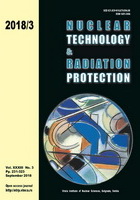
ELEMENTAL COMPOSITION OF MOSS AND LICHEN SPECIES IN EASTERN SERBIA

Vol.
XXXIII, No. 3, Pp. 231-323
September 2018
UDC 621.039+614.876:504.06
ISSN 1451-3994
Pages: 275-285
Authors: Jelena V. Ajtić, Darko Z. Sarvan, Branislava M. Mitrović, Ana A. Čučulović,
Rodoljub D. Čučulović, and Marina V. FrontasyevaAbstract
Instrumental neutron activation analysis is used to determine a content of 47 elements (Na, Mg, Al, Cl, K, Ca, Sc, Ti, V, Cr, Mn, Fe, Ni, Co, Cu, Zn, As, Se, Br, Rb, Sr, Zr, Mo, Ag, Cd, Sb, I, Ba, Cs, La, Ce, Nd, Sm, Eu, Gd, Tb, Dy, Tm, Yb, Lu, Hf, Ta, W, Au, Hg, Th, and U) in mosses (Homolothecium sp., Hypnum cupressiforme Hedw., and Brachythecium mildeanum (Schimp.) Schimp.) and lichen (Cladonia fimbriata (L.) Fr.) collected in three locations in Eastern Serbia over years 2006-2010. Concentrations of six elements (Zr, Nd, Gd, Tm, Yb, and Lu) in mosses in Serbia are measured for the first time. For other elements, the obtained concentrations fall within the ranges reported for mosses and lichens in Europe, but no declining trend in concentrations of V, Cd, Cr, Zn, Ni, Fe, and Cu, that has been described in the literature, can be inferred from our results. Factor analysis shows that terrigenous and industrial components are the highest contributing factors to the elemental composition and that the most polluted measurement site is in the vicinity of a copper mining and smelting complex.
Key words: biomonitoring, moss, lichen, instrumental neutron activation analysis,
elemental composition, factor analysis
FULL PAPER IN PDF FORMAT (550 KB)